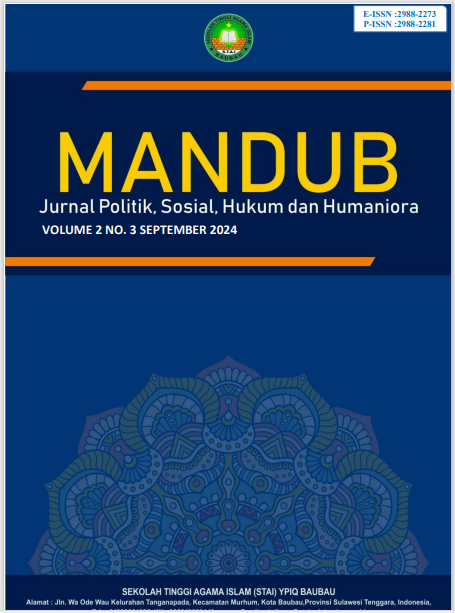Pertanggungjawaban Pidana Bagi Pelaku Tindak Pidana Pencurian Data Nasabah Perbankan dengan Mode Skimming Ditinjau dari Undang-Undang Nomor 1 Tahun 2024 Tentang Informasi dan Transaksi Elektronik
DOI:
https://doi.org/10.59059/mandub.v2i4.1760Keywords:
Legal Liability, Skimming, Legal Protection, Skimming Prevention StrategyAbstract
Banking is one of the financial services companies that has provided services to the community and businesses, Behind this development there are various legal problems related to information crime and electronic transactions in the banking sector, Skimming is the act of stealing debit or credit card information by accessing an independent cash machine and copying the information contained on the magnetic stripe of the debit card or credit belonging to the customer (victim) illegally to have control over the customer's (victim) account. The application of the law to the crime of ATM skimming is regulated in Article 362 of the Criminal Code (KUHP) regarding the crime of theft. This research is a type of normative judicial research supported by a normative approach by using primary legal materials, secondary legal materials and tertiary legal materials as data sources. This study uses a prescriptive method, which is an analysis method that provides an assessment (justification) about the object being researched whether it is true or false, or what should be according to the law. The results of the study show that (1) Skimming is a magnetic stripe crime that exists on ATM cards illegally to have control over the card or the account by duplicating the ATM card or by installing a hidden camera to find out the ATM PIN of the customer or victim. (2) Strategies to prevent unauthorized access and early detection of suspicious activities can be applied to reduce the incidence of criminal acts and effective cyber security is to strengthen the network and security system. This can include investing in cutting-edge security technologies, such as robust firewalls, active network monitoring, and security programs that can detect suspicious attacks. In addition, organizations also need to involve their employees in cybersecurity efforts.
References
Adam Chazawi. (2015). Tindak Pidana Informasi Dan Transaksi Elektronik. Malang: Media Nusa Crative.
Ade Arthesa dan Edia Handiman. ( 2009,). Bank dan Lembaga Bukan Bank Edisi 3,. Jakarta:: Indeks.
Chazawi., A. ( 2021.). Kejahatan Terhadap harta Benda. Malang:: MNC Publishing.
Dian Ekawati, (. 1.-u. (2018). “Perlindungan Hukum Terhadap Nasabah Bank Yang Dirugikan Akibat Kejahatan Skimming Ditinjau Dari Perspektif Teknologi Informasi Dan Perbankan,”. Unnes Law Review 1, no. 2, hal. 159. Diambil kembali dari https://review-unes.com/index.php/law/article/view/24/15.
Dr.Neni Sri Imaniyati, S. (2020). Pengantar Hukum Perbankan Indonesia. Bandung: PT. Refika Aditama.
Enrick, M. (2022). “Pembobolan ATM Menggunakan Teknik Skimming Kaitannya Dengan Pengajuan Restitusi,”. Jurnal Jurist Diction, Vol. 1 Nomor 2, Agustus 2022, 124-133.
Ida Hanifah, d. (2018). Pedoman Penulisan Tugas Akhir Mahasiswa. Medan: CV Pustaka Prima.
Ilhami Bisri. ( 2005). Sistem Hukum Indonesia. Cet. II; Jakarta:: PT Raja Grafindo Persada.
Kitab Undang-Undang Hukum Pidana
Mahesa Jati Kusuma, ,. (2017,). Hukum Perlindungan Nasabah Bank: Upaya Hukum Melindungi Nasabah Bank Terhadap Tindak Kejahatan ITE di Bidang PerBankan. Bandung:: Nusa Media,.
Melania Karsa MR. (2022). Pedoman Penulisan Tugas Akhir. Kupang: FH.
Muladi dan Barda Nawawi Arief. (1998). Teori-Teori dan Kebijakan Pidana. Bandung: Alumni,.
Nugroho, J. L. A., Manafe, D. R. C., & Dima, A. D. (2024). Penegakan Hukum Pidana terhadap Pelaku Tindak Pidana Penjual Pangan Kedaluwarsa di Tinjau dari Undang-Undang Nomor 18 Tahun 2012 tentang Pangan di Kelurahan Lasiana, Kecamatan Kelapa Lima, Kota Kupang. Mandub: Jurnal Politik, Sosial, Hukum dan Humaniora, 2(4), 25-37.
Pawit M. Yusup dan Priyo Subekti. (2010). Teori dan Praktek Penelusuran Infomasi (Informasi Retrieval) . (Cet. I; Jakarta: , ): Kencana Prenada Media Group.
Raida L. Tobing. (2010)). “Penelitian Hukum Tentang Efektivitas UU No. 11 Tahun 2008 Tentang Informasi dan Transaksi Elektronik”, Laporan Akhir. (Jakarta:: Badan Pembinaan Hukum Nasional,.
Roeslan Saleh, L. (Loc.Cit.). Loc.Cit. Loc.Cit.: Loc.Cit.
Sinlaeloe, L. I., Medan, K. K., & Manafe, D. R. C. (2024). PERLINDUNGAN HUKUM TERHADAP DATA PRIBADI PEMINJAM DALAM LAYANAN APLIKASI PINJAMAN ONLINE (STUDI KASUS DI KOTA KUPANG). Petitum Law Journal, 1(2), 584-595.
Shaikh Aijaz Ahmed dan Shah Syed Mir Muhammad. (2012). Auto Teller Machine (ATM) Fraud – Case Study of a Commercial Bank in Pakistan, International Journal of Business and Management.
Sri Redjeki Hartono, H. A. (2001). Hukum Asuransi dan Perusahaan Asuransi. Jakarta: Sinar Grafika.
Supromono, G. (2014). Hukum Uang Indonesia. Dyokarta: Gramata Publishing.
Undang-Undang ITE
Undang-Undang Perbankan
Undang-undang RI Tahun 1945
Victoria Linggoharjo, M. H.-t.-j.-k.-p.-m. (2020). Tanggung Jawab Kejahatan Perbankan Melalui Modus Operandi Skimming,”. Magister Hukum Arumentum 7, no. 1. Diambil kembali dari https://media.neliti.com/media/publications/339486-tanggung-jawab-kejahatan-perbankan-melal557e7cc7.pdf
Yulies Tiena Masriani. ( 2017). Pengantar Hukum Indonesia . Jakarta: Sinar Grafika.
Zaidan., A. (2015). Menuju Pembaruan Hukum Pidana. Jakarta : Sinar Grafika.
Downloads
Published
How to Cite
Issue
Section
License
Copyright (c) 2024 Mandub : Jurnal Politik, Sosial, Hukum dan Humaniora

This work is licensed under a Creative Commons Attribution-ShareAlike 4.0 International License.








